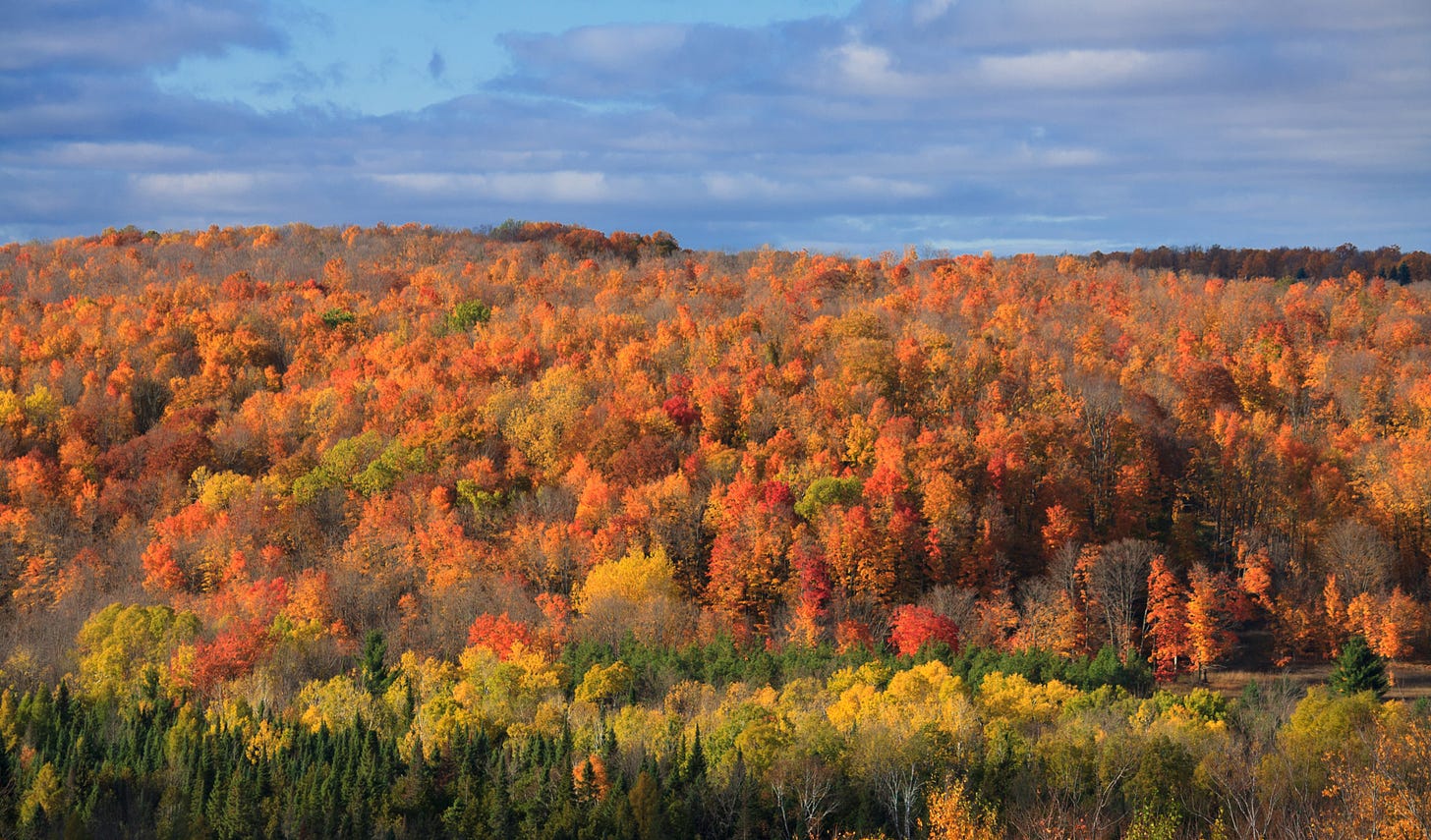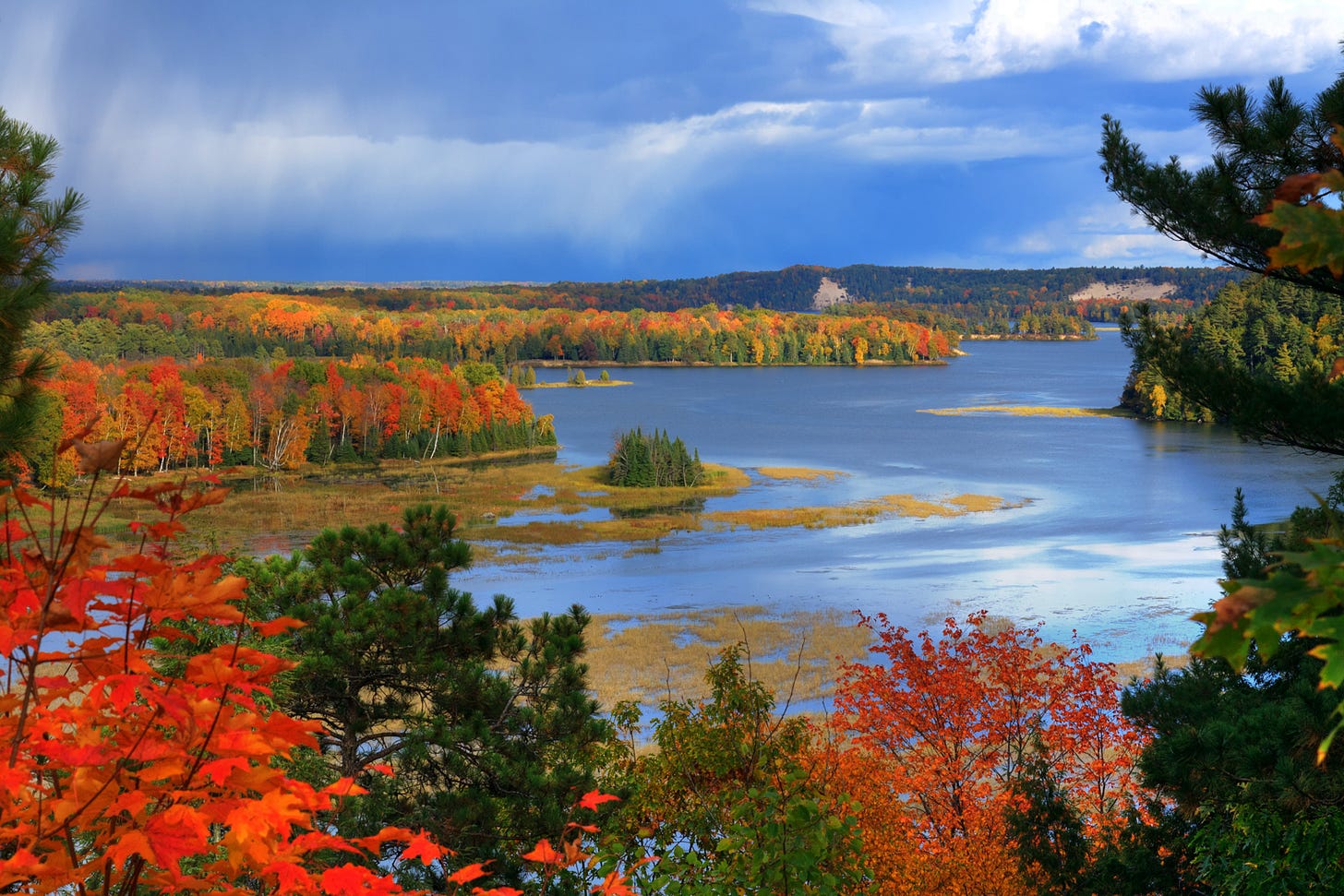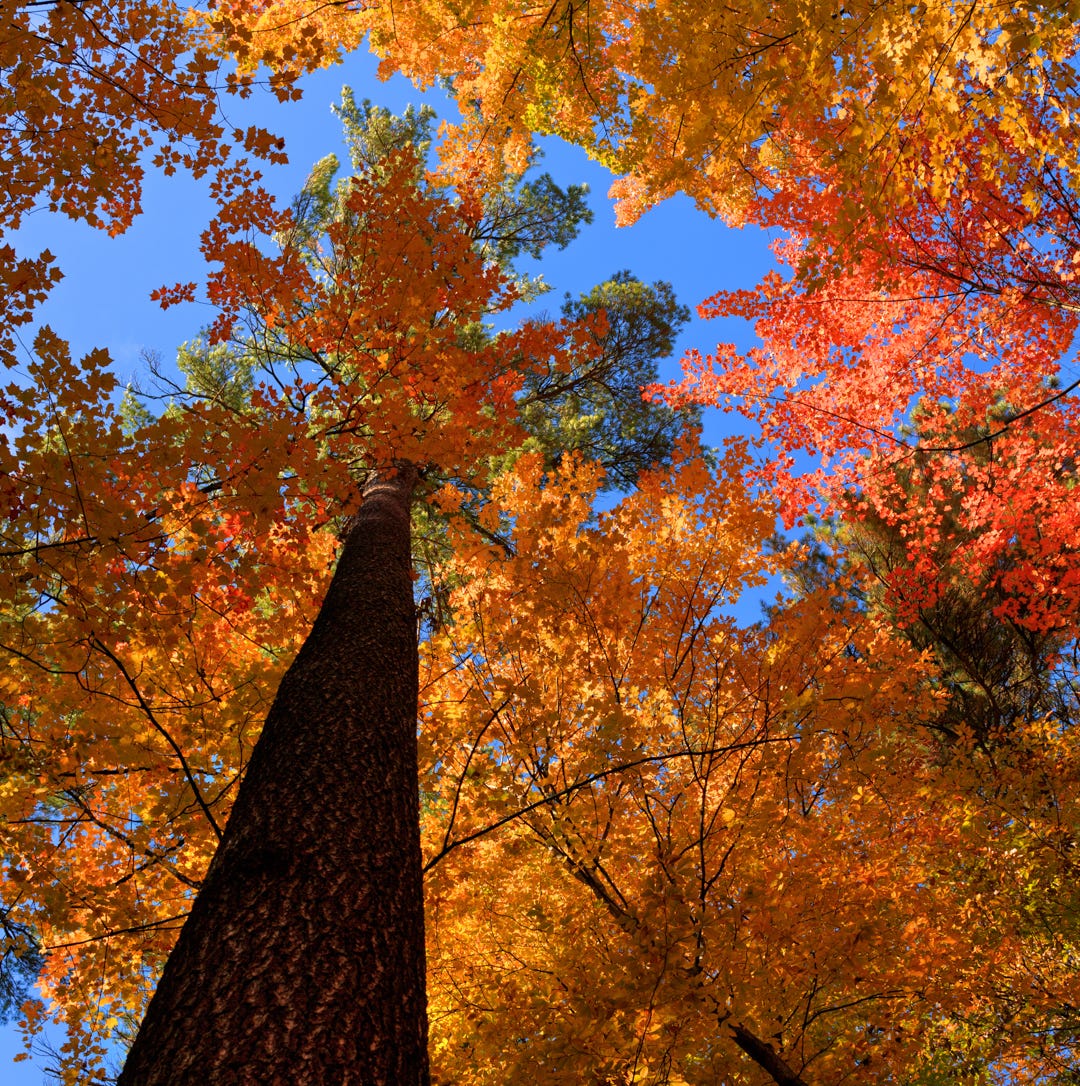The Totally Comprehensive and Infallible Guide to Michigan Fall Colors
(Or at least good enough to get you pointed in the right direction and save some travel time)

Every year, social media is flooded with requests by leaf peepers eagerly seeking fall color spots in Michigan. Talk to a dozen people and you’ll get a dozen sets of overlapping recommendations, and the responses are subjective. There isn’t a singular “Michigan Fall Color Top 10.” In fact, good fall colors are pretty easy to find if you know where to look. Michigan puts on a dazzling fall color display that spans the state.
Regional tourism bureaus also complicate the responses to the most common questions, as they’re all competing to get leaf peepers to explore their own neck of the woods and spend tourism dollars on apple cider, pumpkin-spiced lattes and seasonal trinkets at their own local businesses.
I’ve been fortunate to be able to extensively explore Michigan’s fall colors over many years. I’ve accumulated a large enough library of what I consider gallery-worthy fall color photos from across the state and I think I can provide some basic tips for when and where to reliably find good fall colors in Michigan.
Timing is Everything
The most important thing to keep in mind when planning your fall color tour is that hitting peak color in a given location is always tricky. Even the most spectacular location can be a dud if you arrive a week early or a few days late, or if a storm rolls through the night before and knocks down all the leaves. On the flip side, even a hidden pocket of color off the beaten path can dazzle you if you see it at the right moment. Local TV meteorologists do their best to provide some forecast of when the color will mature, but fall color presentation depends on many different factors that are hard to measure and are currently almost impossible to predict. In my experience, seasonal fall color maps and forecasts are pretty hit-or-miss.
Generally speaking:
The Upper Peninsula tends to hit peak in the last week of September through the first week of October. Coastal areas will turn a bit later. Inland areas or areas where cool air sinks and pools overnight will turn faster. The western U.P. tends to turn first, and the eastern U.P slightly later.
The Lower Peninsula is more complicated. Just outside of Gaylord, there is a small area that has a seasonal climate very similar to what you find in the U.P., a two hour drive north. The area around Gaylord yields reliable vistas of fall color, but it can turn fast and earlier than other parts of the state, making it easy to miss. I try to check it out in early- to mid-October. It usually gives me a pretty good idea of when to expect fall colors elsewhere in the Lower Peninsula. It’s a good early indicator.
Radiating out from Gaylord, fall colors follow a more predictable, intuitive progression. Northern inland areas turn first, followed by southern areas and coastal areas. The western half of the Lower Peninsula tends to turn earlier than the eastern half. In a climatologically normal year, the northern half of the Lower Peninsula is afire in a wave of color between the first weekend in October and the third week of October. It’s rare that many leaves are still on the trees after, say, October 25th.
In the southern part of the state, the quality of fall colors is much more variable. Draw a line from Pentwater to Pinconning across the state as a reference. Getting the timing right for fall colors south of that line is much harder but still doable. Fall colors can appear through the end of October in the southern half of the state if the conditions are right and the weather doesn’t knock down the leaves.
From all of the above, you can surmise that there are some competing geographic factors at play that make it challenging to get the timing right. Fall colors move north to south, but also from inland to coastal, and also from higher elevation to low, and also from cold air pockets and exposed breezes to warmer spots. All those factors rarely line up in the same direction, and we haven’t even mentioned the role that local weather patterns can play. Most of the underlying conditions for color progression can even change in the span of a few miles, so having some prior local knowledge about the places you’re interested in helps a lot.
My general recommendation is to plan to be flexible. Don’t put all your eggs in one basket. If you’re traveling some distance to find fall colors, have a mix of inland and coastal destinations in mind before you get there. If you’re ahead or behind the colors in one spot, you‘ll probably be able to find near-peak color in another.
Look for the Right Type of Forest
Almost the entire Upper Peninsula and most of Northwestern Lower Michigan are the best parts of the state to find fall colors. Why? Those areas have the forest types that provide a vibrant mix of yellow, orange and red.
Aspen, birch, and beech trees display beautiful yellows. Maple trees can show off a spectrum from yellow to red. In a good year, even the oaks will turn heavenly gold and deep wine-red.
The forest-type to look for is the Maple-Beech-Birch forest type as described by the U.S. Forest Service. That forest type is prevalent across the Northwestern Lower Peninsula and most of the Upper Peninsula. In particular, most people find sugar maples and red maples stunning, as they can turn the signature orange and red colors people associate with fall. In broad terms, you’ll find that forest type in the quarter of the Lower Peninsula that is north and west of Houghton Lake (along I-75 and west, along M-55 and North).
The map below from the U.S. Forest Service shows forest types in Michigan. The light green, Maple-Beech-Birch forest type and the orange Aspen-Birch forest type are what you’re looking for. The yellow areas are predominantly pine trees. The uncolored areas are dominated by row crop agriculture or developed land and have few trees of any kind.
There are pockets of good forest types in the southern half of the Lower Peninsula, but they tend to be smaller, more spread out, and far more variable in when they produce good color.

Location Recommendations
If you’re coming from far away or planning to spend a week in a place, it’s hard to beat the Upper Peninsula or the Grand Traverse Bay area. Hit the timing right and you’ll be immersed in fall color. That said, both of those places are not easy to travel to for many, especially if you only have a weekend to spare.
The webpage ExploreFall.com has a good interactive slider feature that lets you see the typical progression of color across the state. For the states I’m familiar with, it looks pretty accurate in terms of the relative progression.
Generally speaking:
Look for places that have a lot of hills.
Sudden changes in elevation profile provide vistas and transitions in color from top to bottom. The western U.P., Pictured Rocks National Lakeshore, Sugarloaf Mountain near Marquette, and the Mission Hill Overlook near Bay Mills are good examples in the U.P.
The Lower Peninsula is flatter and high viewpoints are harder to find, but Sleeping Bear Dunes National Lakeshore, Deadman’s Overlook, west of Gaylord, and off-season ski resorts like Shanty Creek near Bellaire and Treetops near Gaylord are some good examples.

Look for other nearby interesting features, like dunes, rivers, lakes, and waterfalls.
If the fall colors don’t pan out, you’ll still have fun exploring those places. Tahquamenon Falls is a quintessential fall color destination that fits that rationale, but in recent years, it’s become so popular and the viewpoints so crowded that it’s hard for me to recommend. If you can, visit it on a weekday. It’s also a good spot to check out with cloudy or dreary weather, which will also drive away the fair weather leaf peepers.
(The World Waterfall Database maintains a catalog of waterfalls in Michigan. I’ve distilled their map for easy use and removed some of the inaccessible, off-limits, or falsely-placed waterfalls.)
In the Lower Peninsula, some examples of photogenic features are the Manistee River, the Au Sable River, and the Huron River. These rivers provide lots of interesting turns, riffles, and great opportunities to hike in picturesque settings. They are also closer to major population centers like Detroit, Grand Rapids, and Ann Arbor which reduce the travel-related carbon-emissions of getting to them. I consider the Au Sable River to be Michigan’s somewhat hidden gem, so much so that I hesitate to mention it for fear of burdening it with additional traffic. High viewpoints abound from good hiking trails and high dunes that drop down to the river’s edge. Even the areas that have been segmented by dams are picturesque, and the unobstructed, free-flowing stretches are everything a natural river can be: beautiful, restorative, inspiring.
Across the state, public lands are great places find fall colors. In addition to providing critical ecological functions for people and wildlife, protected natural resources are especially valuable for leaf peepers in developed areas like southeast Michigan. State parks, Metroparks, and local parks are usually safe bets to find at least some good pockets of color.
In southeast Michigan, the “green crescent” that primarily spans Oakland and Livingston Counties in the Huron and Clinton River watersheds boasts several large state and metro parks. Island Lake State Recreation Area, Pinckney State Recreation Area, Waterloo State Recreation Area, Seven Lakes State Park, and each of the Metroparks along the Huron River are great places to start. Just getting to any one of those places will give you ideas to explore elsewhere.
Leave No Trace
Michigan’s fall color destinations have become more popular as photos featuring beautiful views have spread on social media. With that increased attention has come increased damage from people and traffic, especially in areas where off-road vehicles are allowed. Remember to stay on marked trails, to pack-out all your waste, to take only pictures and leave only footprints.
Help Protect Natural Areas for Climate Change
The fall color season has gotten slightly shorter and slightly later since the middle of the 20th century, due to changes in several factors. Climate Central has a nice summary here. Overall, a later first-freeze, prolonged summer warmth, and chaotic precipitation patterns have compressed the optimal period of fall colors. The later average peak color date also means trees are more likely to lose their leaves during a storm before reaching their full glamourous potential. All that said, color quality varies tremendously from year to year, with some years still reaching peak quite early.
With warming temperatures, the forest types that produce vibrant colors will also become less prevalent in Michigan over time. Beech and birch forests are especially sensitive. Some healthy forest types can migrate northward or to suitable areas at a maximum rate of about 100 kilometers (~62 miles) every 100 years. Climate change is currently shifting the optimal temperature ranges faster than that, faster than our beloved deciduous forests can naturally migrate. The result will eventually be that less colorful forests from the south will out-compete the “Up North” forests that we know and love.
To slow that warming progression, reducing planet-warming emissions by reducing fossil fuel use is critical. For that reason, start by exploring fall color destinations that are as close to you as possible.
Protecting natural lands is also one of the most beneficial things we can do to prepare our forests for change, to keep them healthy and able to adapt. To avoid catastrophic ecological breakdown, we should be protecting half of all earth ecosystems from human development. Wilderness protection should be a top priority for state legislators. Call your state senator and representative and tell them to protect one acre of land for every acre that is developed. There are also numerous local land conservancies across the state that deserve your charitable donations. Here is a pdf map from Heart of the Lakes that shows the land conservancies that need your support.





